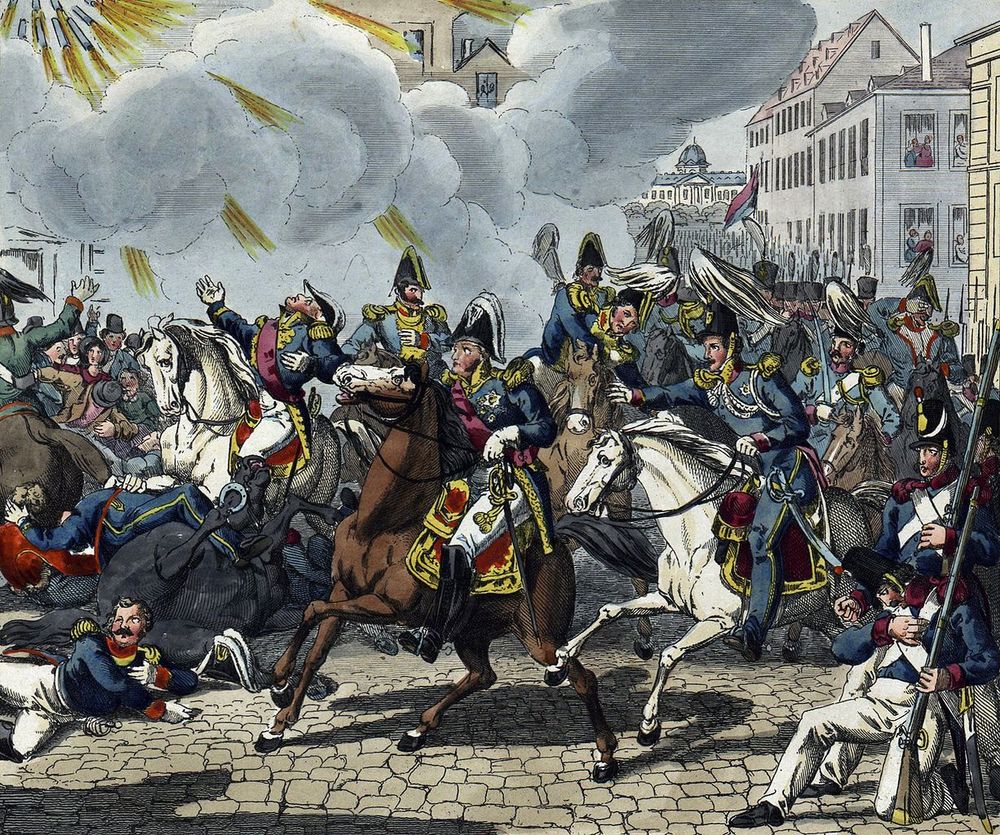On July 28, 1835, Giuseppe Marco Fieschi positioned himself in front of an open window on the third floor of N. 50 Boulevard du Temple in Paris. Overlooking the window was a street that King Louis-Philippe of France was expected to pass through as he went for his annual review of the Paris National Guard. Fieschi intended to assassinate the King, and to make sure he had a high degree of success, he designed one of the most infernal guns in history.
Giuseppe Fieschi's infernal machine at the French History Museum, Paris. Photo: Parisette/Wikimedia
Giuseppe Marco Fieschi was born in 1790 on the island of Corsica to a landless, impoverished family. He spent his childhood and adolescence as a shepherd. When he turned 18, he joined a Corsican regiment and was sent to Naples, and then to Russia to fight in the Napoleonic Wars. In 1814, Giuseppe left the army and returned to Corsica to join former King of Naples Joachim Murat in an ill-fated attempt to regain his kingdom, and ended up being arrested. Giuseppe escaped execution and was deported to France, where he was sentenced to 10 years in jail for the theft of a steer.
After spending a few years as a vagrant, Giuseppe obtained a small post in Paris by means of forged papers, but upon losing his job and pensions that he had fraudulently obtained, Giuseppe resolved to revenge himself on society. Shortly after, Giuseppe joined his disgruntled neighbor Pierre Morey, and the two conspired to assassinate King Louis-Philippe. But first they needed a gun.
Instead of firing a single shot at the king and risk missing it, Giuseppe and Morrey decided to build a volley gun with 25 barrels placed side by side. They took the plan to another conspirator, Theodore Pepin, who the gave the plan legs. Because Giuseppe was penniless, the cost of building the “infernal machine”—about 500 francs—was split between Pepin and Morey, while Giuseppe did the building. Eventually, Giuseppe had the gun ready.
The weapon, built of wood and metal, was constructed in a room overlooking the street on the third floor of N. 50 Boulevard du Temple—the same room from which he would fire his gun. The barrels were mounted side by side with each touch hole in line with the next. In combination with a trail of gunpowder, the barrels could all be fired at once with a single fuse. Each barrel contained about 6 to 8 balls and an additional 13 to 14 slugs. It was a powerful killing machine indeed.
The annual review, which commemorated the 1830 July revolution, took place on 28 July 1835. At around noon, Louis-Philippe and his entourage was passing along the Boulevard du Temple, accompanied by three of his sons, when Giuseppe fired the weapon. A terrible explosion ripped through the air showering the passing company with a volley of projectiles. Men and horses dropped immediately and the street was filled with the dead and dying. One witness reported that there was suddenly “a void around the king.” Napoleonic war hero Marshal Mortier and his horse lay in a bloody heap on the pavement. Lieutenant-Colonel Rieussec of the 8th Legion was killed instantly. Colonel Raffet, commandant of the Gendarmerie, also fell to the ground. He died several hours later. The king only suffered a minor graze to the forehead, but eighteen other people were killed at the scene, or later died from their wounds.
Assassination attempt by Giuseppe Fieschi on King Louis Philippe I of France on July 28, 1835.
Unfortunately, the weapon was too powerful and too crudely made. When Giuseppe lighted the fuse, the gun literally exploded sending bullets all around the room. Giuseppe was thrown back towards the wall, sustaining bullet injuries to his head, face, and hand. Despite his injuries, Giuseppe managed to pull himself up and before the king’s guards could rush into the building, he used a rope to swing out of the room into the adjoining building. But Giuseppe was badly injured and bleeding. The guards soon caught up to him by following the trail of blood he left.
Fieschi's trial became a great spectacle and he enjoyed his stardom. “During the trial Fieschi clearly embraced his celebrity status,” wrote Jill Harsin in Barricades: The War of the Streets in Revolutionary Paris, 1830-1848, “[he] assumed that the slightest details about himself would interest the court, and entered into numerous narcissistic rambles about his thoughts, emotions, and habits.”
Giuseppe was found guilty and sentenced to death along with Pierre Morey and Theodore Pépin. On 19 February 1836, the three were taken to the guillotine and their heads chopped off. Pepin was the first to go, followed by Morey. Fieschi was the last, and he used this opportunity to give a little speech: “I’m going to appear before God! I have spoken the truth. I die content. I have rendered a service to my country in signaling my accomplices. . . . I regret my victims more than my life.”
The head of Fieschi after his execution. Oil painting by Jacques Raymond Brascassat
Fieschi's head went to a doctor at Bicêtre Hospital where a postmortem examination of his brain was carried out to determine if it exhibited features that might explain his behavior. The original gun is now on display at the Musée des Archives Nationales, the state museum of French history, in Paris. A replica of the weapon is on display at the Musée de la préfecture de police, the museum of police history.















Its a great story but finished line was full of sadness. Photos are great as story.
ReplyDelete